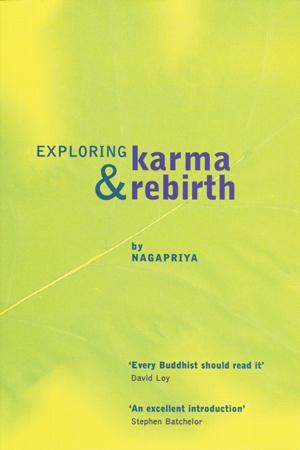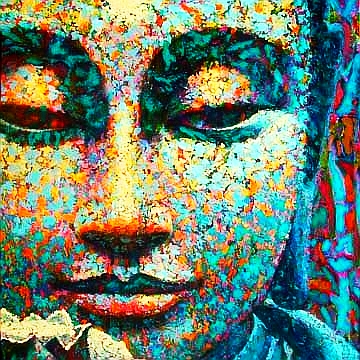Graham Lock

As some people said they liked my review of David Loy’s book (well, two people actually), I thought I would again present some musings on what I have been reading.
Nagapriya’s Exploring Karma and Rebirth is not a new book (it was published in 2004), but I came across it only recently in a secondhand bookshop. I’m glad I did, because although it covers some very familiar ground, it has been very useful in clarifying my understanding of some issues that have long nagged at me.
There are basically three three main strands in the book. One deals with what Nagapriya considers to be misunderstandings of the Buddhist teachings on karma and rebirth. Another explains clearly and in quite a lot of detail what the traditional Buddhist teachings are, and talks about the difficulties many modern Buddhists might have with aspects of them. The third strand explores different ways of thinking about karma and rebirth that could be useful for modern Buddhists who find the traditional interpretations hard to accept. I’ll just focus on one or two points that I found useful and interesting in each of these strands.
One major misunderstanding of the Buddhist view of karma that he cites is the claim that everything one experiences in life is the fruit of one’s karma; in other words, that all the pain we currently suffer is a consequence of bad deeds we have done in the past, and all the benefits we currently enjoy are the consequences of the good deeds we have done in the past. He cites chapter and verse to show that, according to early Buddhism at least, the Buddha explicitly denied such an interpretation of karma. Nagapriya in fact considers this ‘a dangerous misunderstanding,’ as it can lead to blaming the poor, sick or oppressed for their plight and refusing to help them, and in extreme cases, it can lead (and has led) to such horrible claims as that the Jews in the Nazi death camps must have done something terrible in their previous lives to “deserve their fate.”
I doubt that this ‘everything that happens is due to karma’ notion is very widespread among Buddhists today, although I have occasionally heard Western lay Buddhists express something like it, and I have also been told that it sometimes arises among Thai Buddhists, where may be used as an excuse for not supporting certain charitable activities. But it is certainly not a mainstream Theravada teaching, nor I think do most Mahayana schools teach this version of karma. But is it very useful to be reminded that it is a misunderstanding that can arise.
As for what the Buddhist teachings on karma and rebirth actually are, Nagapriya recognizes that the sutras do not speak with one voice. On the one hand, there is what he calls the “folk” model of karma according to which, for example, someone who kills beings in one life will be short-lived in a future life, someone who is prone to anger will be reborn ugly, someone who is ungenerous will be poor, and so on. He regards this as a ‘fairly crude and simplistic’ model whose main use was to encourage people to do good deeds. Such a magical, “punishment-fits-the-crime” view of karma is certainly one which I think many (though not all) modern Buddhists have difficulty accepting.
 On the other hand, the Buddha also presented a subtler, more psychologically-oriented account of karma according to which every choice we make, every willed mental, verbal or physical action we take, contributes to modifying our character, to forming what we become. Through skilful choices we develop creative habits and through unskillful choices we develop destructive habits. “For better or worse, we are constantly renewing ourselves, even with each passing thought,” as Nagapriya puts it. It is, I think, this view of karma – that we are not stuck forever with our current character and all the bad habits that constitute it and that we are always “a work in progress” – that so many people today find helpful, even liberating.
On the other hand, the Buddha also presented a subtler, more psychologically-oriented account of karma according to which every choice we make, every willed mental, verbal or physical action we take, contributes to modifying our character, to forming what we become. Through skilful choices we develop creative habits and through unskillful choices we develop destructive habits. “For better or worse, we are constantly renewing ourselves, even with each passing thought,” as Nagapriya puts it. It is, I think, this view of karma – that we are not stuck forever with our current character and all the bad habits that constitute it and that we are always “a work in progress” – that so many people today find helpful, even liberating.
Nagapriya accepts that rebirth is central to the Buddha’s teaching, particularly as it relates to karma and its fruition. Unlike some, he does not try to claim that rebirth or reincarnation was simply an idea widely accepted in the culture of the Buddha’s time that he happened to go along with. Nor does he claim that whether one believes in rebirth or not makes no difference. However, he does recognize the difficulties many people, including some Buddhists, have with the idea of rebirth. In fact, as he points out, making sense of rebirth, and in particular reconciling it with the concept of anatman (non-self), i.e. that there is rebirth but no “I” to be reborn, has long been an issue for Buddhists. The Buddhist tradition has come up with many new doctrines to resolve this apparent contradiction, some of which he describes as “highly bizarre” and he concludes that “it is arguably a question that has never been satisfactorily answered.”
The fact that we don’t understand the process of rebirth, or rather that there are so many contradictory understandings of it, does not, of course, mean that rebirth is not in some sense true. Nagapriya devotes one chapter to reviewing the evidence for it, especially past life recollections. His conclusion is that “the evidence that exists in support of rebirth is certainly not compelling, but at least some of it is plausible and hard to explain using established knowledge.” He suggest that the “most honest response” would be to admit that we just don’t know.
In exploring alternative ways of thinking about karma and rebirth he makes it clear that his concern is how these notions can help us live more creatively, even if we do not believe in them literally.
Rather then taking a mechanical “X action leads to Y result” view of karma, he suggests thinking of it more organically. Just as when we eat a cake we don’t separately experience the taste of every ingredient that has gone into it, we similarly
“experience an overall karmic momentum that has been set in motion by a large number of actions.” And instead of the traditional idea of “transference of merit” we can bear in mind that our actions may have an impact on others, either positively or negatively. Our actions can even significantly alter the course of other people’s lives, for better or worse.
 If we cannot accept the traditional concept of rebirth, we can understand it as a metaphor that communicates how our current actions can have implications beyond our death and even far into the future, ‘perhaps in ways we might not have imagined.’ Rebirth can be seen as kind of renewal, with the possibility of breaking free from suffering within this life, leading us to a “happier, more fulfilled existence.”
If we cannot accept the traditional concept of rebirth, we can understand it as a metaphor that communicates how our current actions can have implications beyond our death and even far into the future, ‘perhaps in ways we might not have imagined.’ Rebirth can be seen as kind of renewal, with the possibility of breaking free from suffering within this life, leading us to a “happier, more fulfilled existence.”
However, he does caution that “any practitioner of Buddhism must be wary of dogmatic acceptance or rejection of rebirth, and an examination of the motives for taking any particular view will be very instructive.”
It seems to me that the strengths of this book are firstly that it very clearly and as far as I can judge accurately describes the traditional Buddhist concepts of karma and rebirth, showing that they are sometimes subtler and more complex than some commentators give them credit for. At the same time, Nagapriya fully recognizes the difficulties that many modern Buddhists have with some of the pre-scientific and seemingly magical aspects of the early teachings in this area, and he explores ways in which they might usefully re-think them. Throughout all this, I never felt I was being pressured to take up any one particular viewpoint.
If, like me, you missed this book when it came out over a decade ago, you might like to give it a try. I think it is suitable both for those who know very little about the Buddhist concepts of karma and rebirth, and for those who may be quite familiar with them but would like a broader view of different ways of thinking about them.

Very interesting analysis.
Thank you Sarah!
I was typing this long message about not understanding and in the process it clicked. Thank you, great article and I’m glad I stopped to think over it for a while.
Thank you Austin. Good to get your comment.